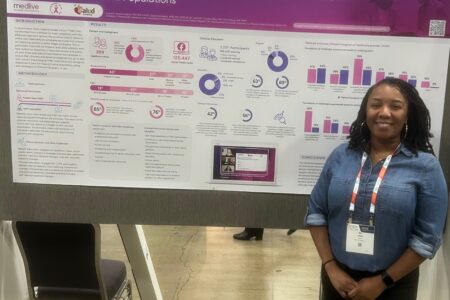
Share On Social!
Latinos continue to be one of the most overlooked groups in high-paying jobs, such as careers in science, technology, engineering, and mathematics (STEM).
Of the 34.9 million Americans working in STEM fields, only 8% are Latino as of 2021.
Latinos are fewer than 10% of the workforce in the fields of health careers (9%), life science (8%), physical science (8%), computers and math (8%), and engineering (9%).
The technology industry also lacks Latino visibility.
One in every five US workers is Latino, and only one in 10 of them have a job in tech. There even fewer in leadership tech roles, according to a new Kapor Foundation report.
This paints a stark contrast to the growing number of Latinos in the US.
Latinos currently make up 19.1% of the US population, and are expected to rise to more than 84 million by 2030, accounting for nearly one-quarter of the US population.
Over the next decade, 78% of US labor growth will come from Latinos.
“With nearly 80 percent of new jobs over the next decade going to a Latino, the critical need to increase education, skills, opportunities, and sense of belonging for Latin[o] in technology is beyond an investment in our community, but in the present and future of the United States to compete globally,” Antonio Tijerino, the president and CEO of the Hispanic Heritage Foundation, said in the report.
Latinos in Tech
Tech is a growing industry that employs millions of Americans; however, Latinos continue to make up a small portion of the tech workforce.
One of the biggest tech areas lacking Latino visibility is leadership.
Latinos comprise 5% of executive leadership roles and of those holding tech company board seats, only 3% are Latino, according to the Kapor Foundation report.
Few Latinos also make up venture capital professionals (6%) and partner-level venture capital investment professionals (5%).
When venture funding reached its peak in 2021 with a $250 billion investment, Latino tech founders only received 3%.
Capital given to Latino entrepreneurs accounted for 1.3% of venture investments during a slowdown of funding in 2023.
When it comes to technical roles across large US tech companies, Latinos only account for 6% of the workforce.
If this rate continues, Latino improvement in the tech industry won’t be achieved until 2077.
Latinos are also still making less money than their white counterparts.
For every dollar made by white men, Latino men earn 3% less while Latinas make 8% less.
The Latino population have also been unevenly affected by recent tech layoffs with Latinos comprising 11.5% of laid off tech employees.
Tech Education
The economy is experiencing a technical renaissance stemming from technological advancements such as artificial intelligence, machine learning, and cloud computing.
The introduction of some of these new technologies is expected to drive the creation of 280,000 tech jobs over the next decade, according to the Kapor Foundation report.
Over the next decade, careers in data science and data analysis are projected to grow by 266%, cybersecurity expected to grow by 242%, and jobs in software development by 180%.

The anticipated growth of the Latino population and corresponding workforce, coupled with the projected industry growth, the report stressed the importance of investing in early tech education.
“It is essential to provide and sufficiently resource high-quality CS for all students across K-12 public education. And yet, significant challenges exist for Latin[o] students, ranging from inequitable access to high-speed internet and high-quality CS courses … to a shortage of trained educators, and a limited network of racially and ethnically aligned role models,” the report said.
Currently, only 78% of Latino students have access to foundational computer science courses in high schools, compared to 82% of white students and 89% Asian students.
Despite making up 29% of the high school population, 21% of students enrolled in foundational computer science courses, 20% of students enrolled in AP computer science principles, and 12% of students enrolled in AP computer science applications courses are Latino.
Language is another challenge to improving computer science education in schools.
10% of students are English Language Learners (ELL) and 75% of the ELL population are Spanish language speakers.
Despite that, only 6% of ELL students are engaged in foundational computer science courses.
Fewer opportunities for computer science exposure have created fewer pathways to higher education and jobs in tech for Latinos.
Addressing Tech Education Challenges
The rising Latino population makes it essential to understand the unique challenges and opportunities they face in the tech industry, Mariela Salas, the executive director of SomosVC, said in the report.
“By drawing attention to this part of the ecosystem, we can identify the barriers that hinder Latin[o] representation and participation in the sector and develop strategies to overcome them,” Salas said.
In addressing the issues to early tech education, the report suggests expanding computer science by mandating foundational courses and integrating computer science concepts and skills across different subjects.
Other areas of improvement in K-12 computer science education includes diversifying the teaching workforce, offering a culturally responsive curriculum, equipping educators with bilingual resources, and invest in an infostructure that supports high speed internet.
For online resources, check out CASA Code Toolkit by UnidosUS, Code as a Second Language (CSL) en Espanol by the Hispanic Heritage Foundation, and Computer Science for English Learners (CSforEL) by the Computer Science Teachers Association (CSTA).
To increase Latino presence in the tech workforce, special attention should go to expanding postsecondary computer science education, such as community colleges.
Creating partnerships between institutions with high Latino enrollment and tech companies, expanding financial aid, providing resources such as help with childcare and transportation, and improving transfer to 4-year colleges and universities can impact Latino tech careers.
Increasing the Latino tech workforce doesn’t stop at education.
Work must also focus on improve the hiring process and promote a healthy workplace culture for everyone.
Addressing some of the issues in the tech workplace consist of creating new employment outreach opportunities for potential new hires, support Latino representation across all levels, establishing a fair and unbiased salary practices, and instituting a system to report situations of discrimination.
To explore additional recommendations and educational resources, download the full report here.
Improve Health Gaps Where You Live
Just like systemic and institutional issues stand in the way of high-paying jobs, like the ones in the tech field, gaps have a way of impeding in other areas of life.
Poverty, access to healthy food, and access to reliable transportation can impact someone’s wellbeing by preventing them from getting the care they need or determining what kind of job they can get.
The best way to address some of these challenges is to be responsive to the foundational issues going on in your community by downloading a Salud America! Health Report Card.
The Health Report Card determines the health of your community in areas such as access to clean air, a quality education, and housing, compared with the rest of your state and the country.
Maps and data included in the Health Report Card can be used to help drive policy changes, speak to the need for program expansion, or help you create a community project.
Explore More:
EducationBy The Numbers
142
Percent
Expected rise in Latino cancer cases in coming years



